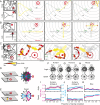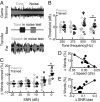Immersive audiomotor game play enhances neural and perceptual salience of weak signals in noise
- PMID: 24927596
- PMCID: PMC4078866
- DOI: 10.1073/pnas.1322184111
Immersive audiomotor game play enhances neural and perceptual salience of weak signals in noise
Abstract
All sensory systems face the fundamental challenge of encoding weak signals in noisy backgrounds. Although discrimination abilities can improve with practice, these benefits rarely generalize to untrained stimulus dimensions. Inspired by recent findings that action video game training can impart a broader spectrum of benefits than traditional perceptual learning paradigms, we trained adult humans and mice in an immersive audio game that challenged them to forage for hidden auditory targets in a 2D soundscape. Both species learned to modulate their angular search vectors and target approach velocities based on real-time changes in the level of a weak tone embedded in broadband noise. In humans, mastery of this tone in noise task generalized to an improved ability to comprehend spoken sentences in speech babble noise. Neural plasticity in the auditory cortex of trained mice supported improved decoding of low-intensity sounds at the training frequency and an enhanced resistance to interference from background masking noise. These findings highlight the potential to improve the neural and perceptual salience of degraded sensory stimuli through immersive computerized games.
Keywords: cortical; foraging; gradient search; hearing; noise suppression.
Conflict of interest statement
The authors declare no conflict of interest.
Figures






Similar articles
-
Audiomotor Perceptual Training Enhances Speech Intelligibility in Background Noise.Curr Biol. 2017 Nov 6;27(21):3237-3247.e6. doi: 10.1016/j.cub.2017.09.014. Epub 2017 Oct 19. Curr Biol. 2017. PMID: 29056453 Free PMC article. Clinical Trial.
-
Modifying the Adult Rat Tonotopic Map with Sound Exposure Produces Frequency Discrimination Deficits That Are Recovered with Training.J Neurosci. 2020 Mar 11;40(11):2259-2268. doi: 10.1523/JNEUROSCI.1445-19.2019. Epub 2020 Feb 5. J Neurosci. 2020. PMID: 32024780 Free PMC article.
-
Speech in noise perception improved by training fine auditory discrimination: far and applicable transfer of perceptual learning.Sci Rep. 2020 Nov 9;10(1):19320. doi: 10.1038/s41598-020-76295-9. Sci Rep. 2020. PMID: 33168921 Free PMC article.
-
Auditory perceptual learning and changes in the conceptualization of auditory cortex.Hear Res. 2018 Sep;366:3-16. doi: 10.1016/j.heares.2018.03.011. Epub 2018 Mar 12. Hear Res. 2018. PMID: 29551308 Review.
-
Perceptual learning during action video game playing.Top Cogn Sci. 2010 Apr;2(2):202-16. doi: 10.1111/j.1756-8765.2009.01054.x. Epub 2009 Oct 30. Top Cogn Sci. 2010. PMID: 25163784 Review.
Cited by
-
Neural Mechanisms Related to the Enhanced Auditory Selective Attention Following Neurofeedback Training: Focusing on Cortical Oscillations.Appl Sci (Basel). 2023 Jul;13(14):8499. doi: 10.3390/app13148499. Epub 2023 Jul 23. Appl Sci (Basel). 2023. PMID: 39449731 Free PMC article.
-
Cochlear neural degeneration disrupts hearing in background noise by increasing auditory cortex internal noise.Neuron. 2021 Mar 17;109(6):984-996.e4. doi: 10.1016/j.neuron.2021.01.015. Epub 2021 Feb 8. Neuron. 2021. PMID: 33561398 Free PMC article.
-
Mice Develop Efficient Strategies for Foraging and Navigation Using Complex Natural Stimuli.Curr Biol. 2016 May 23;26(10):1261-73. doi: 10.1016/j.cub.2016.03.040. Epub 2016 Apr 21. Curr Biol. 2016. PMID: 27112299 Free PMC article.
-
Air traffic controllers' long-term speech-in-noise training effects: A control group study.Noise Health. 2016 Nov-Dec;18(85):376-381. doi: 10.4103/1463-1741.195804. Noise Health. 2016. PMID: 27991470 Free PMC article.
-
Neurotoxicity and Outcomes from Developmental Lead Exposure: Persistent or Permanent?Environ Health Perspect. 2023 Aug;131(8):85002. doi: 10.1289/EHP12371. Epub 2023 Aug 28. Environ Health Perspect. 2023. PMID: 37639477 Free PMC article.
References
-
- Stephens D, Krebs J. 1987. Foraging Theory (Princeton Univ Press, Princeton)
-
- Charnov EL. Optimal foraging, the marginal value theorem. Theor Popul Biol. 1976;9(2):129–136. - PubMed
-
- Greggers U, Menzel R. Memory dynamics and foraging strategies of honeybees. Behav Ecol Sociobiol. 1993;32(1):17–29.
-
- Kennedy JS. Zigzagging and casting as a programmed response to wind-borne odor—a review. Physiol Entomol. 1983;8(2):109–120.
-
- Porter J, et al. Mechanisms of scent-tracking in humans. Nat Neurosci. 2007;10(1):27–29. - PubMed
Publication types
MeSH terms
Grants and funding
LinkOut - more resources
Full Text Sources
Other Literature Sources
Medical

